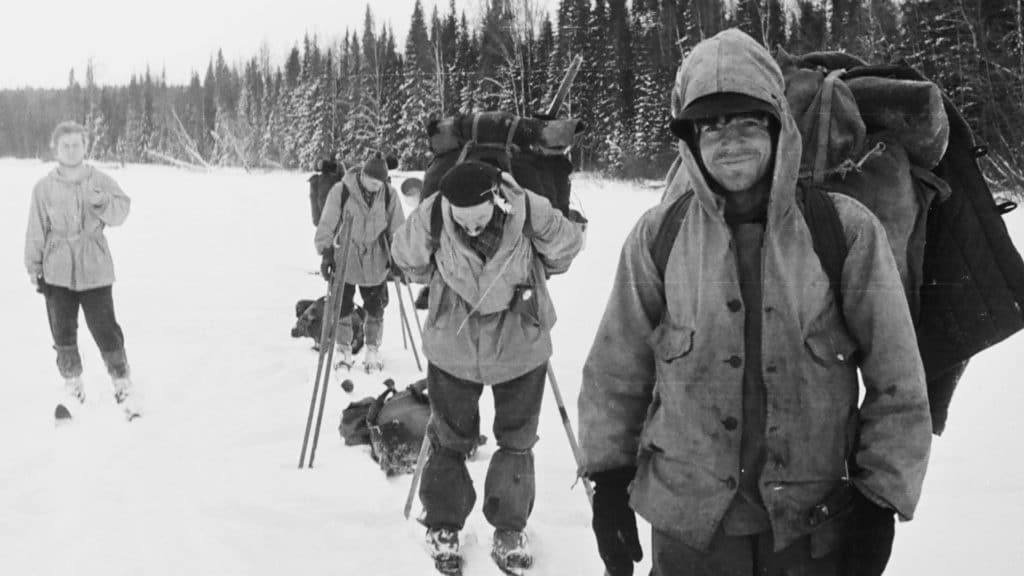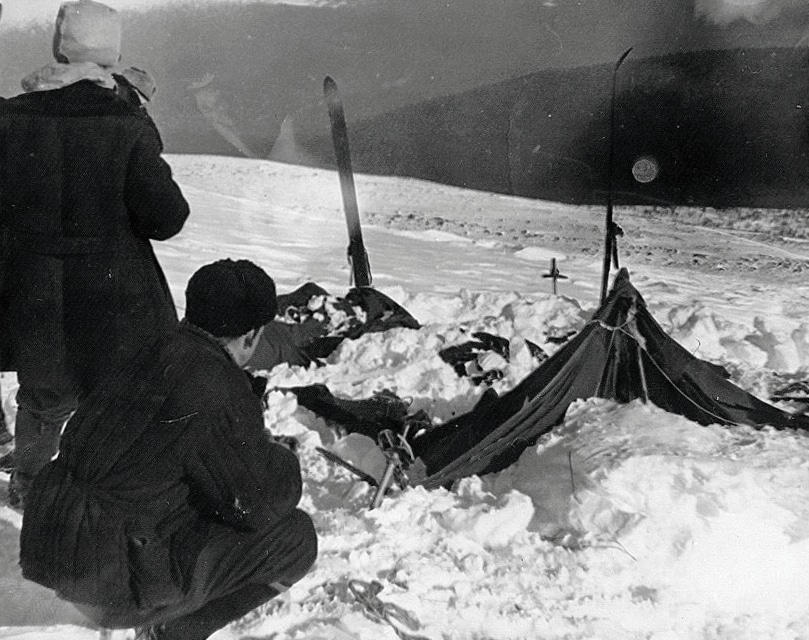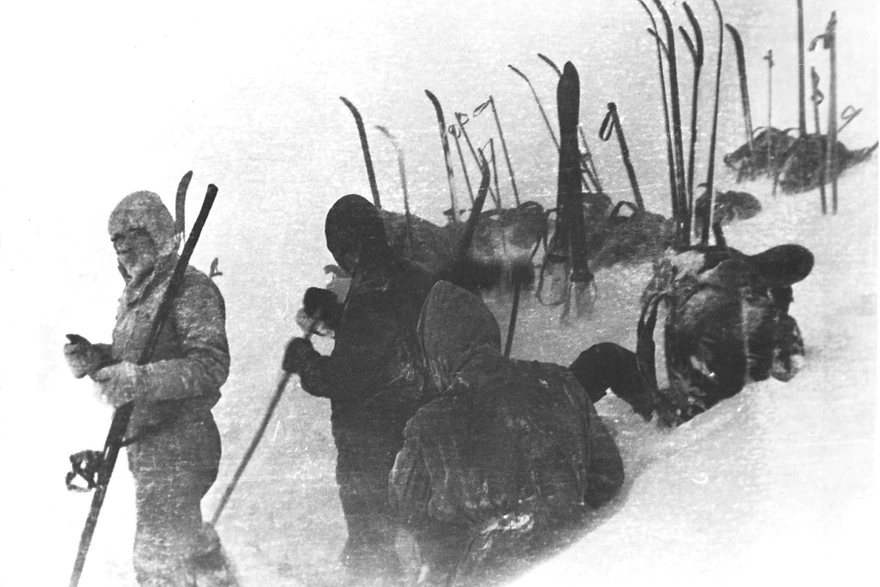Last updated on September 28th, 2022 at 10:06 pm
In 1959 a group of Soviet Russian explorers from the Ural Polytechnical Institute inexplicably fled their camp and perished in the Ural Mountain range.
With various injuries and a lack of proper gear, many have wondered what pushed these experienced explorers to flee their tents and abandon their camp with little gear, only to mysteriously perish to a mix of physical trauma and the harsh elements.
To this day, many believe that the incident results from foul play, government interference, or the inexplicable.

Prepping for a Pass
Igor Dyatlov, a 23-year-old student at the Ural Polytechnical Institute, formed a team of nine of his peers to partake in a skiing expedition through the northern Ural Mountains.
The expedition members were trained in both hiking and skiing and would receive a higher certification in both areas after completing this trek. The local government approved the group’s route, and the expedition was set to take place in the most difficult season of the year.
Igor Dyatlov, Yuri Doroshenko, Lyudmila Dubinina, Yuri Krivonishenko, Alexander Kolevtov, Zinaida Kolmogorova, Rustem Slobodin, Nikolai Thibeaux-Brignolles, Semyon Zolotaryov, and Yuri Yudin all left for the expedition in late January. Yuri Yudin had to turn back five days into the trip due to an injury.
The remaining expedition party members continued through the Ural Mountains for another four days.
An Unexpected Exit
On the night of February 1st, 1959, the expedition group set up camp at the base of Kholat Syakhl in the northern section of the Ural Mountains range. Something forced all nine expedition members to flee the tent in the night and head towards the tree line not far away.
The tent had been cut for a quick exit, and the hikers fled with inadequate clothing for their environment. Despite the heavy snowfall and extremely low temperatures, the hikers left in light layers, and some even fled without shoes.
All nine members of the expedition party were found lifeless near the campsite. The cause of their demise was not immediately apparent. Despite the obvious answer of the elements, the individuals sustained bizarre injuries that further complicated the story. It is still unclear to this day what drove the expedition team from their campsite and into the arms of certain doom.
An Eye-Opening Investigation
The investigation of the incident can be seen as just as bizarre as the incident itself. From 1959 to the present day, new information is still being discovered. The investigation began directly after the first five bodies were found. A legal inquest sparked a medical examination inconclusive on the cause of their demise.
It was initially decided that all five of the first explorers found had passed of hypothermia. The story quickly changed when four more bodies were found four months later.
Unlike the first five bodies, this second grouping was found at the bottom of the creek and exposed to running water. All four individuals had sustained high-impact injuries similar to those received in high-speed car crashes.

These hikers had fatal injuries to the skull and chest, but the most bizarre part of this secondary investigation was the soft tissue damage sustained by each hiker. According to the medical examiner, each soft tissue wound happened post-mortem.
One hiker was missing his eyebrows, while another was found without eyeballs. The third hiker, Dubinina, was found to be missing her eyes, tongue, lips, and fragments of her skull.
Due to these injuries and the location of the initial camp, it was speculated that the Mansi tribe was responsible. The Mansi people were an indigenous tribe of reindeer herders known to dwell in the northern part of the Ural Mountains, near where the explorers were found.
However, after several interviews with the Mansi people and a closer look at the campsite, it was determined that the Mansi Tribe was not responsible for what happened on the mountain.
One of the most compelling aspects of the initial investigation was how three of the hikers were slain. All three of these hikers perished from massive internal blows without damaging their soft tissue.
This led investigators to believe that these blows were caused by a natural force, not the human hand. With the lack of an identifiable guilty party, the investigation was shut down, and all of the evidence and case files were placed in a secret archive for almost sixty years.
A few more minor investigations took place between 1997 and 2019. One of the investigator’s relatives released never before seen film negatives from one of the hikers.
Later on, another hiker’s body, Zolotarev, was exhumed with claims that the hiker’s DNA did not match any of the living relatives. After a facial reconstruction, journalists could match the remains to pictures of Zolotarev taken before the incident.
In 2019, the Russian authorities reopened the investigation into what happened on that night in 1959. However, authorities were quick to denounce any claims of a crime occurring. The official report states that the only explanations that the investigation was considering included an avalanche, a hurricane, and other natural disasters.
What Really Happened on that Mountain?
The official investigation took just over a year to complete and concluded that the nine explorers exited their tent in a hurry to flee an oncoming avalanche. Investigators believe that the experienced hikers heard the tell-tale sounds of an avalanche and quickly had to cut their way out of their tents and run through the snow to safety.
Based on the injuries the individuals sustained, the positioning of the bodies, and a series of computer simulations, an avalanche was ruled the official cause.
Despite being ruled as the official cause, many still are not sure that an avalanche is a true cause. Contradictory evidence shows that an avalanche may not be the most likely or plausible answer. The most harrowing detail of the entire incident is that there was no physical sign of an avalanche during the original investigation of 1959.
Furthermore, over one hundred expeditions have gone out in the same area of the Ural Mountains, and not even one reported avalanche-like conditions.

This contradictory evidence leaves room for many theories about what happened to the hikers on the Dyatlov Pass. Theories range from the plausible to the outright unbelievable, but the mystery has everyone wondering what happened.
One popular theory is that a rare katabatic wind forced the party to flee to the tree line for greater protection. A katabatic wind is a high-density wind flow from high to low altitude that can cause immense pressure and force. A wind of this kind is plausible within the area’s topography and would have forced the explorers out of their tent and into the woods for cover.
A less substantiated claim is that the hikers had unknowingly set up camp in the path of Soviet weapons testing. Theories range from concussion mines, ultrasonic blasts, and radiological weapons.
There are small pieces of evidence used to support each of these claims. Many theorists believe that the evidence does not quite match because of government interference with the bodies and the following investigation.
Another interesting theory is that the expedition team met one of the great mystifying creatures from local lore, the Yeti. Although there is little physical evidence to support this claim, many believe that the force of impact that caused the injuries was far too great to be anything but a supernatural force. Although this theory is entertaining, it is unlikely that the Yeti was the cause of the incident.
Remembering the Fallen
The Dyatlov Foundation continues to honor the fallen hikers with a museum and memorial plaque in the city where the expedition launched from.
The Dyatlov Foundation continues to fund investigations into the Dyatlov pass incident. Despite the captivating nature of the event, The Dyatlov Foundation works to remind the masses that the victims were real people who lost their lives in an unsolved mystery. All nine individuals were students in their early twenties who suffered what was likely a terrifying and painful end at the hands of an unknown force.
The Dyatlov Pass Incident and Popular Culture
The mystery surrounding the incident has presented an opportunity for creative interpretation in books, movies, television shows, and video games. In 1990 the novel The Price of State Secrets Is Nine Lives by Anatoly Gushchin was released, reviving widespread interest in the details of the end of the expedition party.
National Geographic, Discovery Channel, and History Channel have produced documentary series that take a deep dive into the evidence of the incident and explore all the possible causes. Popular culture is captivated by the mysterious nature of the Dyatlov Incident.

